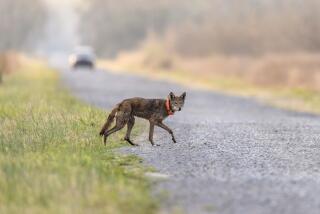Rhode Island Red Making Comeback
- Share via
NARRAGANSETT, R.I. — In a small, penned area in the back corner of a museum lot is a flock of chickens seen by some as a savior, of sorts, for this small state.
Months ago, residents concerned with the decline of the state bird hatched a plan to bring back the Rhode Island Red. They sought to establish a permanent purebred line of the bird admired for its mahogany feathers and coveted for its egg-laying abilities and meaty flesh.
Two local breeders gave the residents eggs from purebred stock, and the group had its “heritage flock,” just in time to celebrate the bird’s 150th anniversary this year.
Wayne Durfee, a retired poultry science professor from the University of Rhode Island, is caretaker of the chickens at the South County Museum in this seaside town. He became worried for the bird’s legacy when its few remaining supporters in Rhode Island began dying.
“That got me to thinking, ‘Where is the Rhode Island Red, and how do we save the bird?’ ” he said.
He and others say the flock is meant to make the Red more visible to the public and to establish an unbroken line of pedigreed birds.
Durfee has loved chickens ever since, as a boy, he’d sit on the back step of his family home in rural North Scituate and call the birds over to eat scratch feed out of his hand.
“They could hear you from 100 yards away, and they’d come scampering across the yard,” recalled Durfee, now 80. They’d sit in his lap and munch on the cracked corn. “They were cute,” he said.
That was the 1930s, when the Rhode Island Red ruled the roost. The buff-chested bird was the fowl of choice at America’s dinner table from the turn of the 20th century through World War II. The hens were renowned for their egg-laying ability, and their bodies, shaped like a horizontal brick from the neck to the tail, were meatier than others.
“The Rhode Island Red itself enjoyed a popularity that few other breeds have attained,” said Don Schrider, poultry specialist at the American Livestock Breeds Conservancy, a Pittsboro, N.C., organization that tracks livestock and poultry. “It was used by many people across the country as a backyard fowl for its meat and its eggs.”
Its beginning was the stuff of luck and pluck.
A Little Compton buyer and seller named William Tripp bought a Red Malay cock in 1854 from a sailor who had steamed into New Bedford, Mass., from Asia. Tripp took it home to run with his scratch hens and crossbred them. He noticed that the offspring were an improvement over the native stock. Word spread.
Poultry farmer Isaac Wilbour bought some of his neighbor Tripp’s cocks and began his own cross-breeding, according to a memoir written by Wilbour’s grandson, David Patten, in 1954, the year Rhode Island made the Red its state bird.
“What he was after was a better all-purpose bird,” Patten wrote of his grandfather’s experiment, “an improved utility fowl that would lay more eggs, bigger and browner eggs for the Boston and Providence markets, and larger bodies to provide more meat.”
The breeding worked. By the 1890s, Wilbour had what local historians say was the first large-scale poultry operation in the country. The Red was admitted to the American Standard of Perfection in 1904. By then, its popularity was cemented. Its eggs were being shipped from Little Compton across the country, and the bird roamed pens on small, backyard lots well outside New England.
The Red’s demise began in the mid-1940s when commercial production took over.
It did not take well to being confined to indoor coops, which businesses wanted to achieve mass-scale production. Also, the Red’s dark plumage extended below the surface of its skin, giving the carcass the pimply look of a teenager’s face.
Consumers wanted white-bodied birds with no visible blemishes, so the Red was replaced by the White Plymouth Rock. Also, family farms began to disappear from the American landscape, and the Rhode Island Red vanished along with them.
By 2002, the Red was on the livestock conservancy’s “watch list,” with 5,000 breeding birds in North America and, more ominously, fewer than 10 primary breeding flocks. It has since been promoted to “recovery” status.
In Rhode Island, flocks plummeted from being on a dozen farms as recently as 30 years ago to two, in Richmond and Scituate.
Durfee and other concerned residents, realizing that the state bird was in jeopardy, got in touch with the two remaining breeders and urged them to donate eggs. The breeders, Warren Carlow and Don Nelson, were happy to help.
Durfee and other volunteers at the South County Museum put the donated eggs in incubators and, in June, they had 25 chicks.
The surviving chicks are the focus of an effort to honor the bird this year.
“I must admit I do get enthusiastic about the Rhode Island Red, even more so in the past few years,” said Durfee, a Rhode Island Red pendant pinned to his baseball hat.
More to Read
Sign up for Essential California
The most important California stories and recommendations in your inbox every morning.
You may occasionally receive promotional content from the Los Angeles Times.












